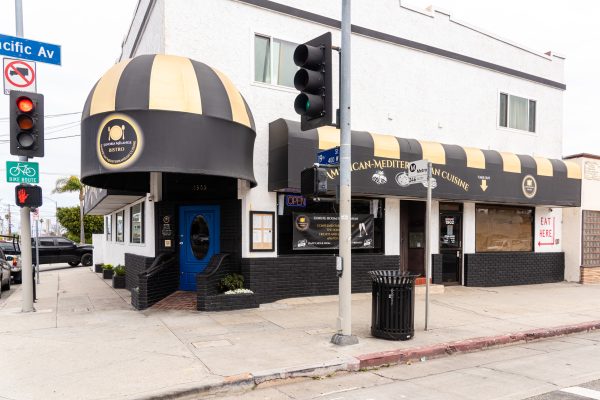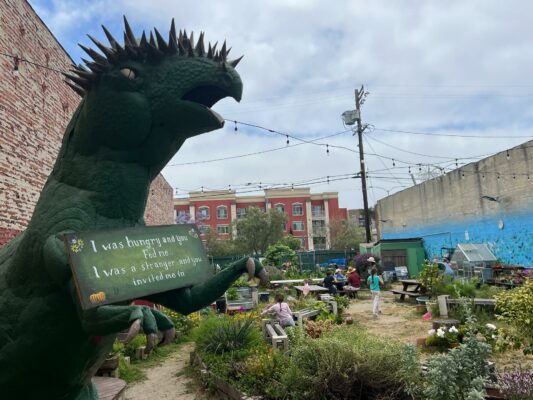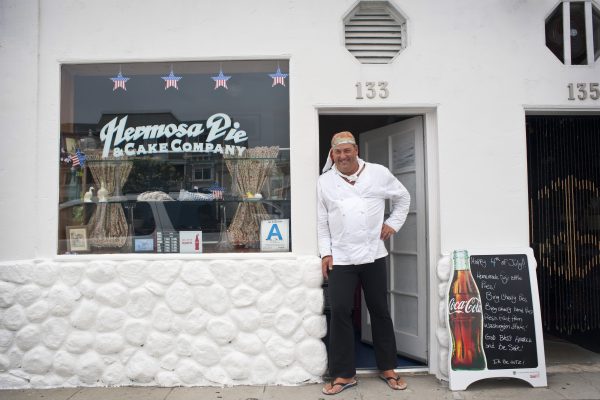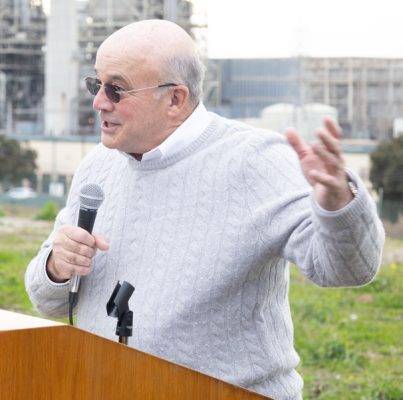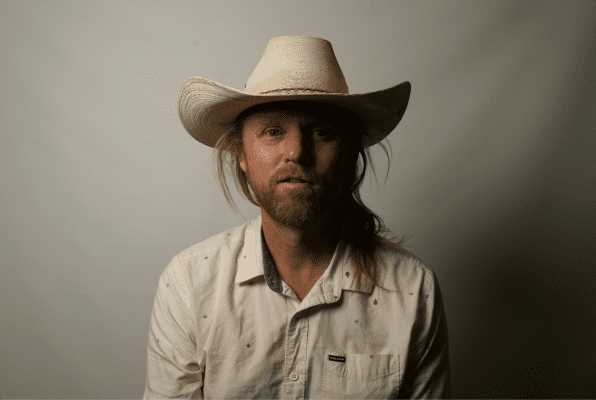
A.J. Bartholomew was already a gigging hard rock guitar player by the time he was a sophomore at Mira Costa High School. He was also a good student, a wrestler and a football player. But everybody already knew what he really was, deep down — a rock and roller.
English teacher Mike McCavan could tell when Bartholomew had gigged the night before.
“He’d come rolling in,” McCavan said. “This wasn’t early — it was 5th period– and he’d still fall asleep. These guys had been playing up in LA the night before. It just wasn’t right to wake him. I’d just let him sleep. I figured he’d get more out of that than Beowulf.”
Around this same time, a scruffy substitute English teacher could sometimes be found on campus. Gavin Heaney was a Class of 1995 Mira Costa grad, and during his foray into substitute teaching — a brief detour from his life as a guitarist and songwriter — administrators would peek into his classroom and have trouble discerning the teacher from the kids. Giddy anarchy was the rule of the day, and discussions of rock and roll were interlaced with English lessons.
“Some of those kids would show up at my shows,” said Heaney, whose band is called Latch Key Kid and whose songs have famously appeared in movies and Super Bowl commercials. “It was cool.”
Such was life at rock and roll high school (Mira Costa was, in fact, a location for the 1979 cult film Rock ‘n’ Roll High School starring the legendary punk band The Ramones). Bartholomew and his buddy Jeff Nisen, a Manhattan Beach kid and fellow American Martyrs grade schooler who went to Loyola for high school, would sometimes play shows outside on the Mira Costa quad. Classmate Kira Lingman would stop and watch — perhaps more attentively than most, observing their hands on the fretboards.
“It was cool,” Lingman recalled. “Everybody knew Jeff and A.J. were the best guitar players around. They had craft.”
Lingman was a closet rock and roller. She woke up one day when she was 16 and decided she wanted to be a blues guitar player. She took lessons, but beyond that she kept it strictly to herself. She would assiduously hone her craft for the next six years, all through high school and college. Lingman, who like Bartholomew is a Mira Costa Class of 2005 grad, wouldn’t play publicly until a few years ago.
“I saw her at Waterman’s,” Nisen recalled. “She doesn’t just play. She rips.”

Mira Costa kids come from a long line of rippers, a fact that will be celebrated May 16 at Costapalooza, a concert at The Lighthouse in Hermosa Beach benefitting the Alumni Association’s mentoring and scholarship programs and the Tiles for Teachers program, honoring retired Mira Costa teachers. The show will feature Latch Key Kid, Lingman, Lose Control (Nisen and Bartholomew’s band), Chloe Caroline (a 2012 grad now making a living as a songwriter in Nashville), and Connor Caine and Friends (another 2012 grad who is an up and coming soul singer).
Chris Warshaw, a Class of 1979 grad who is organizing what promises to be an annual Costapalooza concert, said research for the concert revealed that literally hundreds of bands have emanated from the school from the 1960s to the present.
“All of us who went to Costa grew up with so many great bands, some that made it big and others that never left the garage,” Warshaw said. “We really wanted to bring that spirit of high school friends getting together and trying to make music to our fundraiser.”
“When we started putting this event together and searching for performers, we were blown away by the number of talented Costa graduates out there making great music. The lineup we have is amazingly diverse in styles but all are incredibly talented.”
Lose Control is what Bartholomew describes as a “good old hard rock band” that started when his former punk/metal band AlluraA folded and Nisen’s reggae/rock band Sand Section faded and the two, friends from kindergarten, finally joined forces (bassist Mitch Davis is also a Costa 2005 grad)..
Latch Key Kid, Gavin Heaney’s band, is effervescent California, countrified soul pop. He’s a writer with an unteachable gift for melody, as evidenced by the frequent use of his songs for some of the world’s largest audiences, including a Super Bowl Coca Cola commercial used his song “Good Times” and reached 97 million people.
Lingman, who performs with the band Hollow Legs, is a blueswoman with a rock bent and a soul singer’s voice.
Chloe Caroline is a buoyant singer-songwriter from the Kacey Musgraves/Colbie Caillat school of country and rock who describes herself as “California Country.”
Connor Caine is a blue-eyed soul singer with nods to Sam Cooke all the way up to Sam Smith.
The diversity of Mira Costa’s musical history is indeed reflected by this lineup. Alumni include punk legends Black Flag, the Circle Jerks, and the Descendents, 1960s surf bands The Vibrants and the Galaxies, Grammy-nominated jazz pianist David Benoit, country legends Sweethearts of the Rodeo, rising hip hop artist Cozz, Tim Bluhm of the jam band Mother Hips, and the current lead singer of Foreigner, Kelly Hansen.

But of course there’s one band that rose above the rest: the world-renowned punk band Pennywise. Lead singer Jim Lindberg, lead guitarist Fletcher Dragge and the late great bassist Jason Thirsk all went to Mira Costa. Beyond its global acclaim, Pennywise provided both ritual and soundtrack for most kids who grew up anywhere in the South Bay. For two decades now, Pennywise’s “Bro Hymn” has been the anthem most likely to be drunkenly sung at any gathering at the beach.
“Bro Hymn — we’ve all done it,” Nisen said. “If you say you haven’t, you are lying.”
“It would be silly to say Pennywise is not an influence,” Lingman said.
The influence for Bartholomew is very direct. Dragge helped get his band AllurA on the nationwide Van’s “Warped” tour and even hired the young guitarist to work for his clothing company out of high school.
“Fletcher got me touring,” Bartholomew said. “And I became addicted from there.”
Heaney came through Costa when Pennywise was at the height of their popularity in the early 90s. His first band, AWOL, was a three piece punk outfit and Heaney fondly remembers the hardcore scene that revolved around various local community centers and especially Velocity Studios in Torrance.
“Every weekend there was a radical punk show in that warehouse,” he said. “All kids, basically no supervision, lots of fights — it was gnarly, skinheads-from-Redondo Beach punk show. We opened up for Sublime there, Pennywise played there.”

“I remember thinking that was like going down in the groove. Playing punk, going to Mira Costa — that was the essence of what the Mira Costa thing was for us. Definitely good times…There was a feeling you could just start a punk band and get signed to Epitaph or Fat Wreck Chords. I remember being a freshman and going to see Pennywise and being like, ‘Holy shit!’ It was gnarly. Then seeing a little three piece band, Green Day, open for NOFX when nobody knew them, and like the next week they were huge.”
Pennywise did not emerge from a vacuum. Like bands had been doing for three decades previous to them in the South Bay, Pennywise emerged from garages, basements, old churches, and whatever other rooms could sustain a band practice. Starting from the mid-1960s — when kids across America began plugging in — the ruckus of rock music banged and roared out from unlikely places. In Manhattan Beach, the Doors first practiced in a garage near Sand Dune Park, at keyboardist Ray Manzarek’s parent’s home.
Lindberg said the South Bay’s underground rock scene was a key to Pennywise ever taking shape.
“I was inspired by seeing local bands like Dennis Jarvis’ band The Jetson’s play in my friends living room, and Jenny Davy’s band The Press play at The Neptunian club while I was in high school,” Lindberg said. “Then of course having legendary bands like Black Flag, The Circle Jerks, The Descendents and The Last, not to mention The Beach Boys before them, living in your hometown, you kind of felt like anyone could try it.”
Pat Dietz, who along with his brother John founded Dietz Brothers Music and who has played 6,000 gigs in his life as a professional musician, attended Mira Costa, then Loyola, then Serra, and finally Pacific Shores High School. “I just kept kind of descending down this ladder,” he said. But like other high school rockers, he knew all along that music was the only life for him. He said that in the 1960s, when this explosion of bands began, such aspirations were less frowned upon than in today’s Manhattan Beach.
“Speaking for myself, part of it was out of the Depression, from my parent’s era — my dad’s goal was that we were going to be musicians, lawyers, artists, and doctors,” Dietz said. “We were not going to build houses like he did. And there was a lot of that — people kind of moving up, or wanting their kids to. The funny thing is now, I don’t think many people would see being a musician as being a step up. But they are wrong.”
One thing has remained the same: it usually starts in a garage. Nisen said that when he and his first band, Moss, started playing, the big test was how long it would be until the neighbors called the cops.
“At first we could only go an hour at a time before someone would call the cops,” Nisen recalled. “We were still pretty bad — 12 or 13, hammering through Pennywise or Green Day songs. You could tell how much better you were getting by how long it took people to shut you down — a full two hours, you knew you were getting somewhere.”
Erik Bluhm, a Class of 1985 Costa alum, had a band called the Primates while at Costa. His little brother, Tim, later of the Mother Hips, was essentially forced to become the drummer when they couldn’t find anybody else. Bluhm said a big difference for the bands of the 1960s was that there were ample places to play like the Revelaire Club, the Insomniac, and the Flying Jib. He said when he was coming up in the 1980s, there were no venues that would book original or “punk” music; local bands mainly gigged in Hollywood.
Bands proliferated during the heyday of the 1980s in the South Bay. Bluhm rattles off names of bands that had roots in the South Bay and Costa in particular—Toxic Shock, the Descendents, Redd Kross, Slovenly, the Disposals, the 415s, Distorted Pony, and the Lovedolls. After attending college in the Bay Area, Bluhm returned to the South Bay in the mid-90s and formed a band called Bookmobile, and worked for Theologian Records, the small local label headed by Marc Theodore (who was also in Bookmobile), that put out Pennywise’s first EP. In the late 1990s, Bluhm began throwing shows at the Seafarer Inn in Hermosa with the help of Tom Watson (of Slovenly/Toxic Shock/Mike Watt). There were memorable shows by Melt Banana (from Japan), Jim ‘O Rourke, and members of Sonic Youth.
“I lived in San Francisco for a long time and came back to Hermosa and was like, ‘There’s nothing going on here,’” he said.
Yet somehow Costa keeps on graduating bands. Principal Ben Dale is himself the frontman of a country band called Truckstop. Asked if his students come to shows to heckle, Dale chuckled. “Students have come out to shows and they are always cool,” he said. “There’s plenty of time to heckle me right here at school.”
Dale has a theory as to why he presides over a rock and roll high school — it’s because, he said, the larger community itself supports the arts.
“That was one thing I didn’t really understand until I became principal at Costa — how important the arts are to this community and how it values and sees Costa as the center of arts in Manhattan Beach,” Dale said. “That is really unique — people really look to us for band performances, orchestra, drama, choral music, visual arts….If you are a student in the performing or visual arts, you are kind of at the center of the community, so you grow up with that mindset.”
Lindberg has another theory.
“I think Costa produced a lot of good bands because we’re located near the beach in L.A.,” he said. “The South Bay has been ground zero for what’s cool in the music, surf and skate scene since the 50s. And we’re right in the middle of the world’s largest media empire, so that doesn’t hurt.”
But A.J. Bartholomew, who was kicked out of jazz band his first day on campus, has the most rock and roll of theories as to how Costa came to be a musical epicenter of sorts.
“Man,” he said. “I got nothing.”
Costapalooza is May 16 at The Lighthouse Cafe. Doors open at 6 p.m. and the music starts at 6:30 p.m. and will last deep into the evening. Tickets can be purchased at that door for a $20 donation to the Mira Costa Alumni Association.


